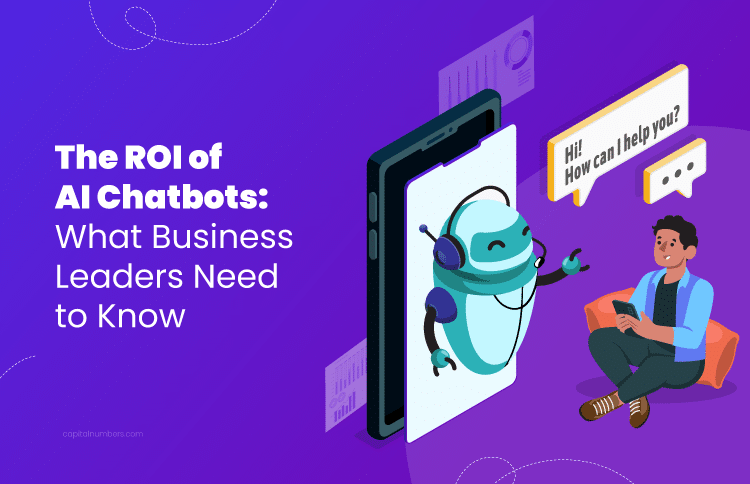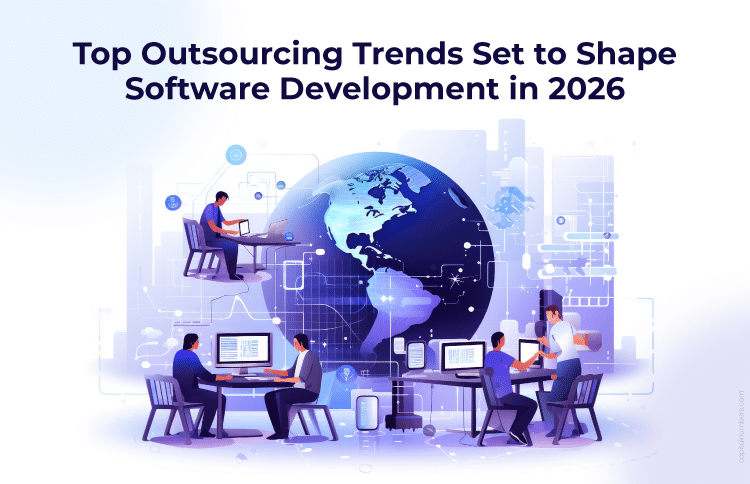The ROI of AI Chatbots: What Business Leaders Need to Know
Table of Contents
The global AI chatbot market is experiencing rapid growth, with projections indicating an increase from USD 6.4 billion in 2023 to USD 66.6 billion by 2033, reflecting a CAGR of 26.4%. This significant expansion shows businesses increasingly turn to AI chatbots for better operational outcomes. But the real question is – are they achieving the ROI they expect? What exactly is the return on investment from implementing AI chatbots?
AI chatbots have evolved beyond simple customer support tools. They are central to enhancing customer engagement, reducing operational costs, and boosting sales. As a result, businesses that invest in AI chatbots are witnessing substantial returns, making them an essential part of their growth strategies.
Understanding the ROI of AI chatbots has become critical for business leaders looking to maximize their investments. Keep reading to know the benefits, associated costs, and key metrics to track the performance of AI chatbots in your business.
Understanding the ROI of AI Chatbots
The ROI of AI chatbots refers to the value businesses get from using them, compared to the costs involved in implementing and maintaining them. It includes savings from reduced labor and operational costs, as AI chatbots automate tasks like answering customer inquiries and processing orders. AI chatbots also improve customer experience by providing instant, 24/7 support, increasing customer satisfaction and retention.
Key Benefits of AI Chatbots for Businesses
AI chatbots bring a range of advantages to businesses, improving efficiency and enhancing customer interactions. Here’s how they help:
Cost Savings
AI chatbots reduce the need for a large customer service team by handling many common queries automatically. This helps businesses save on staffing costs, making customer support more affordable while maintaining quality service.
Scalability
As your business grows, the demand for customer support increases. AI chatbots handle large volumes of inquiries at once, making it easy for businesses to scale without hiring more staff. This scalability is a major advantage of using AI-driven customer service.
Improved Customer Experience
Chatbots provide fast, consistent responses to customers, improving their overall experience. They can respond instantly, anytime, creating a seamless experience that builds trust and loyalty. The result is a better and more efficient customer journey.
Data Insights
AI chatbots gather valuable data during customer interactions. This data helps businesses understand customer needs and preferences, leading to better marketing strategies and more personalized service. It’s a key business benefit of AI chatbots that helps improve decision-making.
Looking to develop a custom AI chatbot for your business?
Get AI development services from Capital Numbers to create efficient, AI-powered chatbots that improve customer engagement and streamline your operations.
Cost of Chatbot Deployment
Deploying AI chatbots involves various costs, but the long-term savings and benefits often outweigh the upfront investment. Here’s a breakdown:
Breakdown of the Costs
The initial cost of developing and deploying an AI chatbot for a business includes the following:
- Development: Costs for designing and customizing the chatbot to your needs.
- Integration: Ensuring the chatbot works with existing systems like CRM platforms.
- Training: Teaching the chatbot to accurately respond to customer queries.
- Maintenance: Ongoing updates and monitoring to keep the chatbot efficient.
Long-Term Cost Savings vs. Upfront Investment
Although the initial investment can be significant, chatbots save costs in the long run:
- Reduced labor costs: Handle routine inquiries automatically.
- Higher efficiency: Quick responses mean faster resolutions.
- Scalability: Chatbots can manage growing customer volumes without additional cost.
Aligning Costs with Business Needs
When considering chatbot implementation, evaluate:
- ROI of AI Chatbots: AI chatbots bring value by automating tasks and improving customer experiences, leading to cost savings.
- Business Benefits: Ideal for businesses looking to scale or handle high volumes of queries efficiently.
Cost Comparison: At a Glance
| Cost Type | Short-term Costs | Long-term Savings |
|---|---|---|
| Development | Initial high cost | Low labor costs |
| Integration | Setup costs | Streamlined workflows |
| Training & Customization | Training required | Improved customer satisfaction |
| Maintenance | Ongoing updates | Reduced support costs |
Key Metrics to Track Chatbot Performance and ROI
To fully understand how well your AI chatbot is performing, it’s important to track both quantitative and qualitative metrics. These insights help evaluate how well the chatbot enhances your customer service and contributes to business goals. Here are some key metrics:
Quantitative KPIs:
- Average Response Time: This measures how quickly the chatbot responds to user queries. Faster responses improve customer satisfaction and show the chatbot’s efficiency.
- Resolution Rate: This tracks the percentage of issues the chatbot resolves on its own. A high resolution rate means the chatbot effectively handles customer inquiries without human assistance.
- Ticket Deflection Rate: This assesses how many queries the chatbot handles instead of passing them on to human agents. A higher rate means fewer resources are required for customer service, improving overall efficiency.
- Cost per Resolved Query: This calculates the cost of resolving each customer issue using the chatbot. Lower costs show that the chatbot is providing value while saving time and money.
- Bot Containment Rate: This measures the percentage of issues resolved by the chatbot without human intervention, showcasing the chatbot’s ability to solve customer problems independently.
Qualitative Signals:
- CSAT and NPS from Bot-Handled Interactions: These track customer satisfaction and net promoter score for chatbot-driven conversations. A positive score indicates the chatbot is providing a good AI-driven customer experience.
- Session Duration and Dropout Points: This analyzes how long customers engage with the chatbot and where they drop off. Understanding this helps improve efficient chatbots by optimizing their responses and flow.
CRM-Backed Analysis:
- Before vs After Data on Ticket Volume or Revenue Per User: This compares ticket volume or revenue before and after the chatbot was introduced. It helps assess how well the chatbot contributes to customer service and sales.
- CRM + Chatbot Integration Helps Show Longitudinal ROI: By combining data from CRM systems and chatbot performance, this metric helps measure the long-term value of your chatbot and shows how it contributes to the overall business goals.
These metrics are crucial for understanding the business value of AI chatbots and making informed decisions about optimizing their performance.
Chatbot Development for Healthcare Industry. Read Success Story
Calculating AI Chatbot ROI: A Step-by-Step Approach
To calculate the ROI of AI chatbots, follow this simplified approach:
Calculate Initial Investment
Sum up all the costs of developing, integrating, and maintaining the chatbot:
Total Investment = Development Costs + Integration Costs + Maintenance Costs
Measure Operational Savings
AI chatbots reduce human agent workload. To calculate savings:
Cost Savings = (Queries handled by chatbot) × (Cost per human agent interaction)
Measure Revenue Impact
AI chatbots can help increase sales by guiding customers or upselling:
Revenue Impact = (Sales assisted by chatbot) × (Average sale value)
Calculate ROI
Now, calculate the ROI using the following formula:
ROI = [(Cost Savings + Revenue Impact) – Total Investment] / Total Investment × 100
By tracking these steps, you can easily measure AI chatbots’ ROI and ensure they deliver business value.
Top Brands Using AI Chatbots for Better ROI
Several prominent brands use AI chatbots to boost customer engagement, reduce operational costs, and ultimately increase their ROI. Here are four well-known companies making the most of AI-driven solutions:
Domino’s Pizza
Domino’s uses its Dom AI chatbot to assist customers with ordering, tracking deliveries, and managing customer service inquiries. It has become a central part of their online ordering system, allowing faster, more efficient service.
Business Impact:
- Increased sales by facilitating faster, convenient ordering.
- Reduced customer service costs by handling a large volume of orders autonomously.
H&M
H&M has implemented a chatbot to guide customers through product searches and help them check out. The AI chatbot improves the shopping experience, making it easier for customers to find the right products and complete purchases.
Business Impact:
- Enhanced customer engagement, driving higher conversion rates.
- Reduced load on customer service teams, allowing staff to focus on more complex inquiries.
L’Oréal Paris
L’Oréal’s Beauty Genius chatbot allows users to try on makeup virtually and receive personalized beauty recommendations. It uses augmented reality to provide a virtual shopping experience, increasing customer interaction and satisfaction.
Business Impact:
- Boosted online sales by offering personalized, interactive experiences.
- Strengthened brand loyalty by providing customers with tailored recommendations.
Macy’s
Macy’s uses a chatbot called Macy’s On Call to help customers find products in stores, get answers to frequently asked questions, and navigate the store. This chatbot has made shopping at Macy’s more efficient, online and in-store.
Business Impact:
- Improved in-store and online shopping experience with quick responses.
- Increased foot traffic and customer engagement with personalized assistance.
These brands have successfully integrated AI chatbots into their customer service and sales processes, achieving better engagement, reduced costs, and a notable return on investment. By focusing on AI-driven customer experiences, they continue to set the standard for customer interaction in the digital age.
What Business Leaders Need to Know Before Adopting AI Chatbots?
AI chatbots offer huge business potential, helping automate tasks, enhance customer service, and improve overall efficiency. However, before adopting them, business leaders need to be strategic about their use. Here’s what you should consider:
Identifying the Right Use Cases for AI Chatbots
To get the most out of AI chatbots, start by identifying where they can add the most value. Whether it’s for customer support, lead generation, or sales assistance, understanding where chatbots can be applied effectively will ensure they drive the business benefits of AI chatbots.
- Tip: Focus on tasks like handling FAQs, booking appointments, or guiding users through a purchase – areas where chatbots can work efficiently without constant supervision.
Setting Realistic Expectations for Chatbot Performance
While AI chatbots can improve efficiency and customer satisfaction, managing expectations is important. They won’t replace human agents completely, but should be seen as tools to enhance service, reduce wait times, and handle routine tasks.
- Tip: Set clear goals, such as improving first-response times or increasing the resolution rate for routine inquiries. Measure progress with chatbot success metrics to see how well your chatbot is performing.
Continuous Monitoring and Optimization
AI chatbots are not “set and forget.” Continuous monitoring and optimization are crucial to ensure they are improving over time. Tracking chatbot success metrics and adjusting based on customer interactions will help enhance their performance and ensure they continue delivering a strong ROI of AI chatbots.
- Tip: Regularly review metrics like customer satisfaction (CSAT) and resolution rates. Use this feedback to fine-tune your chatbot’s responses and improve its efficiency, ensuring a better AI-driven customer experience.
By focusing on the right use cases, setting realistic goals, and monitoring performance, business leaders can unlock AI chatbots’ full business value, driving efficiency, enhancing the customer experience, and boosting ROI.
You May Also Read: AI in the Enterprise: A CTO’s Blueprint for Business Transformation
Bottom Line
AI chatbots are becoming necessary for businesses wanting to improve efficiency, enhance customer service, and see a better return on investment. By automating tasks, cutting costs, and offering AI-driven customer experiences, these solutions are changing industries. With the right metrics and continuous improvements, business leaders can fully unlock the value of AI chatbots and enjoy significant returns.
If you’re ready to build an AI-powered chatbot for your business, choose Capital Numbers. Our expert developers build custom AI chatbot solutions tailored to your business needs. Want to consult on your project needs? Get in touch with us today!


















